|
|
First published in 2001 Voliere2(24) page 196-201 now GEFIEDERTE WELT
Dybowski Twinspot (Euschsitospiza dybowskii)
©Claudia Mettke-Hofmann & Gerhard Hofmann,

1959 was quite an exciting year for us finch-lovers - the first Dybowski’s Twinspots arrived in the Netherlands. There were certainly lots of new arrivals around this time but few of them where so magnificent elegant birds even having a pleasant song.
For years the species was not always beloved because of its aggression and certainly not among the most sought after species among aviculturists. However, the last couple of years before the import ban the species was common even though most finch-lovers were focused on rarer species. Well things changed quite dramatically with the import ban, now Dybowski’s Twinspots are among the most wanted again, and to be honest they are well worth the attention.
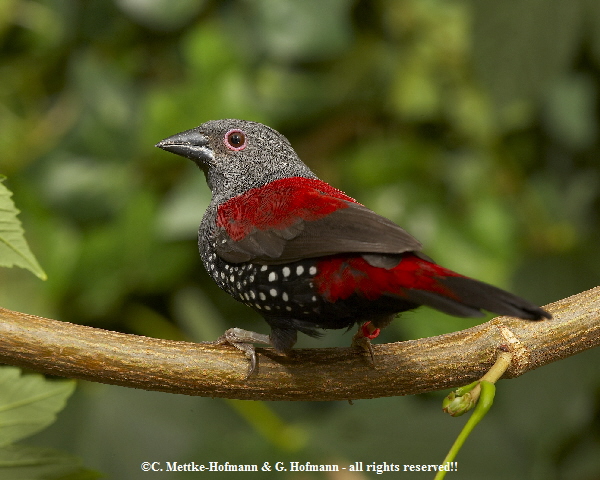 |
Most of our knowledge about this finch is based on observations in captivity. Nonetheless there are still big gaps in the knowledge about the species. According to IMMELMANN, STEINBACHER, WOLTERS (1965) the species ranges from eastern Sierra Leone and from the inner highlands of Nigeria and Cameroon through the area between the wave and Ubangi Shari territory in northeastern Congo to the west shore of Lake Albert and to the south-western bar-el-Ghazal area.
Little is known about the species in the wild, neither about its nutrition nor its behavior. IMMELMANN, STEINBACHER, WOLTERS (1965) write that the birds are found in the grass between the rocks on the riverbank and on the edge of gallery forests and other dense vegetation on trails through the grasslands. They are mainly foraging on the ground searching for grass- and other small seeds as well as insects including the always welcome flying termites, which may be a viable part of their diet in times when only few grass-seeds are available. PAYNE & PAYNE (1995) have demonstrated that in Sierra Leone Dybowski’s Twinspots are hosts for Vidua camerunsis. In this region, the widow males mimick the song of their foster parents - the Dybowski Twinspots.
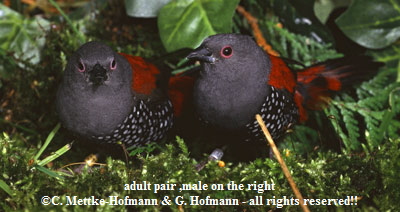 |
The reputation of being very aggressive and therefore not suitable for a mixed aviary didn’t help to make the species more popular among dedicated finch lovers. That may be true for some couples and especially for single males, but certainly not for all individuals.
We started with six pairs all originating from the wild and indeed one pair (actually the male) was totally unsuitable to be housed together with other birds, three pairs were defending their territory sometimes vigorously, but it never came to the dreaded chases and the last two pairs proved completely peaceful towards other birds, even in the immediate vicinity of their own nesting range. The aggressiveness of the offspring was highly correlated with the behavior of their genetic parents. The more peaceful parents produced mostly peaceful offspring, whereas the aggressive parents got mostly aggressive offspring. This is just one of the many behaviors which will change in captivity due to the selection of us breeders. On the one hand this is sad as over time the birds will differ tremendously from their wild relatives but on the other hand this makes them more suitable for captivity … sun and shadow as usual in life. Some species are getting along quite well with Dybowski’s Twinspots whereas with others like most firefinches (Lagonosticta) are a totally different story.
But this doesn’t come as a big surprise as firefinches not only show a tremendous amount of behavioral similarities with the Dybowski’s but are also closely related to them. Interestingly, other species similar in color to the firefinch group like for instance the Strawberry finch were completely ignored by the Dybowski’s. BIELFELD (1996) reported problems when Dybowskis where housed together with Painted Firetails (Emblema picta), but he doesn’t write about the housing conditions.hether it was a large structured aviary or whether they were kept under deprived conditions. Even if the species is kept as a single pair in an aviary or cage we highly recommend some structures where the bird can hide a little; this calms down the birds tremendously and helps in the rare cases when the male starts to chase its own female or the own offspring. Just as an example 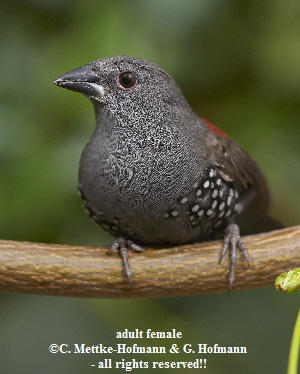 we never had problems when our Dybowski’s were kept together with Timor-Zebra finches, Green Twinspots, Swee Waxbills, Crimson Duskywings, Black-cheeked Waxbills and Red-headed Finches. we never had problems when our Dybowski’s were kept together with Timor-Zebra finches, Green Twinspots, Swee Waxbills, Crimson Duskywings, Black-cheeked Waxbills and Red-headed Finches.
Actually the only ones we had some difficulties were our Timor-Zebrafinches. In two cases newly fledged Timor-Zebrafinches were begging for food … but they were begging to get food from the Dybowski’s Twinspots and in the second case they tried to get some foster-benefits from a pair of Green Twinspots. To make a long story short both Twinspot pairs gave up their fledglings and adopted the Timor –Zebrafinches … a result we were not happy with but while not expected was at least interesting to observe. The genetic parents of the Timor Zebrafinch which took care of them until they fledged were meanwhile incubating already another clutch. It’s needless to say that we removed the Zebrafinches from these aviaries.
Well-structured aviaries and cages help a lot in reducing conflict between Dybowski’s and other species or even between male and female Dybowski’s. [Continue with the sentences above about structured aviaries.]
We also successfully bred the species in large well structured cages. As a matter of fact these pairs were our most successful pairs and often produced 10-15 youngsters per breeding season (maximum three clutches). Our cages had the dimensions of 1.3 x 0.5 x 0.5m and we strongly recommend avoiding smaller ones whereas bigger ones certainly would benefit the birds. We also kept some pairs in outdoor-aviaries, but only during the summer months. As Dybowski’s forage mainly on the ground, we took care that the ground was dry and housed them only in completely sheltered aviaries with roofs. As mentioned before it is extremely important for the welfare of the species that the cage/aviary is structured with plants and offers some dense corners.
D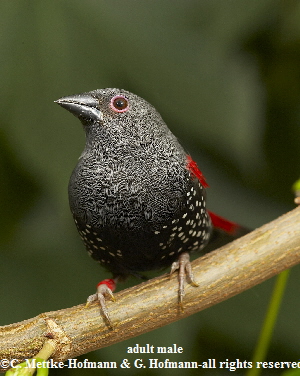 ybowski’s Twinspot really should not be housed in the famous - or should we say infamous - typical breeding cages containing nothing else than three perches a nest box, water and food dispenser and if the birds are lucky a bath. This certainly is not the right substitute for the dense vegetation and highly variable environment the birds are adapted to. ybowski’s Twinspot really should not be housed in the famous - or should we say infamous - typical breeding cages containing nothing else than three perches a nest box, water and food dispenser and if the birds are lucky a bath. This certainly is not the right substitute for the dense vegetation and highly variable environment the birds are adapted to.
Dybowski’s Twinspots love a bit of dense thicket and the cage should be big enough to get one corner decorated with either artificial plants or cuttings (as our birds prefer the cuttings, we went for them but it may not be so easy for folks living in a big city to get hold of suitable plants). The birds like cover and highly appreciate to take their nap well hidden in this thicket. Another benefit is that the birds get quite tame when they can retrieve to what for them is safety … dense cover. In structured aviaries or cages they never act wild and shy, this was even more important for birds imported from Africa but it has to be said that even birds born in deprived conditions will highly benefit from it. These little shelters, which provide a viable structure for the birds serve as hide and escape; not only for other species housed together with the slightly dominant Dybowskis; they also help fledglings or the female to escape and search shelter from an aggressive male. Another big advantage is that the individuals are not always visually present and it is very likely that this helps to reduce aggressive actions significantly.
Enough free space on the ground covered with soil, moss and sand as well as some leaves offers a good environmental enrichment in their daily routines when they search for food. To keep it reasonable clean we used large dishes in which we not only offered the soil, moss and leaves but also the food in particular the insects and germinated seeds. Everything was exchanged daily.
To house Dybowski’s Twinspots in a mixed aviary certainly requires some experience from the bird-keeper and it is nothing we would recommend for a beginner with this species. The nutritional requirements on the other hand are simple. Dybowski’s Twinspots are far from being picky and choosy birds. Our birds were kept on a mixture for African Waxbills from BLATTNER. This mixture is offered dry during the whole year and only occasionally germinated while the birds are in the non breeding stage. During the breeding season the germinated mixture is offered daily and additionally they receive Meadowgrass and Mohair-millet.
Although they prefer to forage on the ground, we offer half-ripe seeds such as spray-, white- millet and various grasses on perches in which we have drilled holes for fixing the various stems. This way the birds could access the seeds from all sides. During the breeding season these milky seeds count for a big part of their daily diet. When it comes to live food Dybowski’s are really not choosy and will accept almost everything that the birds can catch, as well as frozen Buffalos, small mealworms, pinkies or their favorite food ant-pupas. In outdoor-aviaries the birds regularly go on a hunt for spiders and small caterpillars. However, the success rate catching airborne insects is rather modest.
Luckily the species also accepts eggfood or what we call artificial “ant-pupas” (see at the end). What helps a lot is to offer the unknown food directly on the ground and not in the usual food bowls. This way they sometimes accept novel food after just a couple of days; whereas they would ignore it for months when the same food is offered in a food-dish. Like some other species Dybowski’s tend to eat more live-food than is healthy for them. Therefore we restrict it drastically during the non breeding season by only giving very little eggfood and some frozen insects once or twice a week.
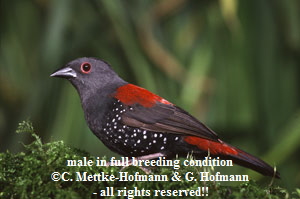 |
When chicks are hatched half-ripe seeds, geminated seeds as well as egg- and live-food are served daily. Egg and live-food are offered in a way that the birds have to search for it. The already mentioned large bowls filled with earth or moss, in which we offer this food have proven to be quite effective to get the birds to work a little. This in fact helps to avoid that the parents will start another clutch and desert the youngsters of the first attempt. Another alternative is to offer small amounts of live food several times per day but this is difficult to organize for most breeders still at work. It serves the same purpose; namely to ensure that the parent birds don’t get in heat again and start again with a new brood before the chicks are independent (QUUOS 1990, CLEWING 1988).
We provide our birds with a mineral-supply consisting of a mixture of Grit and crushed eggshells as well as soil (sterilized soil used for raising piglets (Fa UFA Switzerland)) and burned little twigs of birch. Charcoal granules didn’t work too well for our other birds (but no problems with our Dybowski’s Twinspot) as some of them took too much. Dybowski’s are among the species occasionally suffering from egg-binding. As a precaution we dust their dry seed-mixture as well as the frosted insects with Nekton MSA (a calcium Vitamin D3 supplement which worked excellent for all our birds) from the beginning to the end of the breeding season.
But of course there are many ways leading to success, our method may work for your birds as well but if you already have success …. well never change a winning team. How we feed depends of course on the specific needs of the species, but the housing conditions like temperature, size of the aviaries, etc. play an important role as well. A pair living in a large outdoor aviary together with several other birds will be happy with a high energy-diet whereas the same diet would lead to problems with a pair housed in a breeding cage indoors with more or less the same temperature all year round.
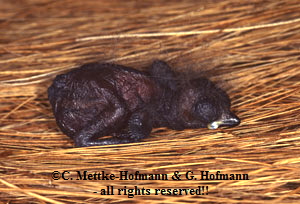
The two basic requirements are housing and nutrition. If we can fulfill these two basic needs of the species, most pairs will start to breed and usually – maybe after one or two failed breeding attempts because they were not fully settled in - raise their offspring without problems. A considerable advantage for breeding in captivity is the fact that the species is easy going in terms of mate choice and all our pairs got along well even the ones which didn’t have the benefit of choosing their mate by themselves.
Vital and dominant males can be easily identified looking carefully at the color of the red eye ring. An intense red eye ring is an indicator of a healthy and dominant individual, whereas a very pale eye ring is often an indicator for health problems or when several males are kept together in the same aviary for a low-ranking male. When females have the chance to choose their mate, they usually go for the males with intense red eye rings. The eye-ring of females is generally lighter colored but can also be seen as a fitness indicator. Just that we have to view it on a different scale …means we can’t compare the color of male and females but when compared with their own sex again the most colorful one is the most dominant female.
When the birds are in breeding condition they will rapidly start to build a nest and it rarely t akes longer than four or six days until the nest is ready for breeding. As most Estrildians they like coconut-fibers and dry long grass. The way they carry the nesting material is similar to the method parrotfinches use. They collect a couple of grass-stems and bundle them to carry them to the nest. Usually the nest is built in dense vegetation. Often they prefer pine or conifers as those probably remind the birds of the thorny scrubs they prefer in Africa (this is true for most species which like thorny acacia). Our birds accepted nesting boxes only when there was no possibility to build their nest in shrubs or dense vegetation. The place they erected their nests varied from close to the ground to 20cm below the aviary roof, most of the nests were at a height of 1.2 m + / - 0.1 m. When we looked at the nests we found a striking difference in thickness of the nest-walls. The nests build in shrubs in our outdoor-aviaries had extremely thick walls, while nests in indoor aviaries built by the same pairs had much thinner walls. akes longer than four or six days until the nest is ready for breeding. As most Estrildians they like coconut-fibers and dry long grass. The way they carry the nesting material is similar to the method parrotfinches use. They collect a couple of grass-stems and bundle them to carry them to the nest. Usually the nest is built in dense vegetation. Often they prefer pine or conifers as those probably remind the birds of the thorny scrubs they prefer in Africa (this is true for most species which like thorny acacia). Our birds accepted nesting boxes only when there was no possibility to build their nest in shrubs or dense vegetation. The place they erected their nests varied from close to the ground to 20cm below the aviary roof, most of the nests were at a height of 1.2 m + / - 0.1 m. When we looked at the nests we found a striking difference in thickness of the nest-walls. The nests build in shrubs in our outdoor-aviaries had extremely thick walls, while nests in indoor aviaries built by the same pairs had much thinner walls.
 We carried out some breeding experiments in cages (1.3 x 0.6 x 0.6m) to learn more about their particular nest preferences. Again the birds avoided nest boxes when possible. As nesting structure we offered conifer-shrub fixed on the left and right side of the cages. The light was not placed in the centre of the cages but asymmetrically, so one half of the cage was lit brightly whereas the other half was much darker. For nesting, the less brightly lit corner was preferred (14 of 18 nests), the nest entrance was pointing to the light source in 15 of 18 nests. The preference for shady places could also be shown in the breeding experiments conducted in outdoor aviaries. We found this preference quite reasonable as a nest exposed to the sun in the wild certainly would be overheated and this could be fatal for the nestlings or eggs. Of course the nest would also likely be more conspicuous and so predation risk would be higher. PENSOLD’S (1974) birds often built their nest directly on the ground in a large mountain of hey. These nests of his birds had a seven to nine cm long entrance tube, which were absent in other nests. The birds from QUUOS (1990) also built their nests on the ground but without an entrance-tube. Therefore, there seems to be quite variation in nest constructions. We carried out some breeding experiments in cages (1.3 x 0.6 x 0.6m) to learn more about their particular nest preferences. Again the birds avoided nest boxes when possible. As nesting structure we offered conifer-shrub fixed on the left and right side of the cages. The light was not placed in the centre of the cages but asymmetrically, so one half of the cage was lit brightly whereas the other half was much darker. For nesting, the less brightly lit corner was preferred (14 of 18 nests), the nest entrance was pointing to the light source in 15 of 18 nests. The preference for shady places could also be shown in the breeding experiments conducted in outdoor aviaries. We found this preference quite reasonable as a nest exposed to the sun in the wild certainly would be overheated and this could be fatal for the nestlings or eggs. Of course the nest would also likely be more conspicuous and so predation risk would be higher. PENSOLD’S (1974) birds often built their nest directly on the ground in a large mountain of hey. These nests of his birds had a seven to nine cm long entrance tube, which were absent in other nests. The birds from QUUOS (1990) also built their nests on the ground but without an entrance-tube. Therefore, there seems to be quite variation in nest constructions.
The outer layer of the nest is usually built with rougher material like large grass-stems, moss or small roots. Then follows a layer of finer material consisting of finer grass or coconut-fibers. For lining [correct!] the nest all our birds showed a highly significant preference for white material in particular white feathers. We offered hairs of a Border-Collie, which contained both blackish and whitish hair. The birds selectively used the whitest hairs. Even young birds that were reared in experimental nests without white lining-material made no difference when they were breeding for the first time. They had never seen white material but still showed the same strong preference for it. So it is very likely that this preference is not learned but genetically determined (METTKE-HOFMANN & HOFMANN 2001). For breeders the knowledge about this preference for white lining material is particularly useful when pairs breed for the first time.
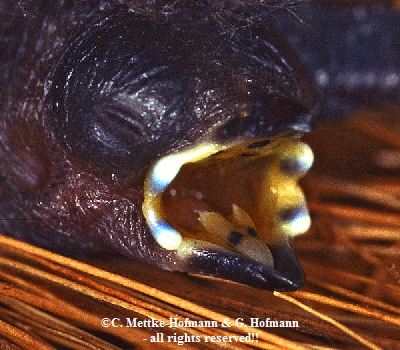 |
Our experiment showed that access to white nesting material had quite an influence on the breeding success. In our experiments four of five first-breeders, which were offered white padding, successfully raised young, whereas the three pairs which didn’t have access to white material failed completely. There was a less strong effect in the second and third breeding attempt but still the white group raised more fledglings per pair. The reason for this behavior may lie in the illumination of the nest-chamber and the strong contrast of dark nestlings against a white background (Dybowski’s Twinspots nestlings are black). For the parents, the chicks and their begging behavior are better visible against the white background as compared to dark background. And this is even more understandable as the birds prefer shady dark places for their nests. Furthermore, the entrance of their nests is pretty small so only few light will enter the nest chamber … to make the best out of this few light – we believe - is one of the reasons the birds like white so much for lining the nest.
But now let’s return to our breeding pair. The first egg is usually laid soon after they are done with nest building. Some pairs will build several nests until they finally will decide which one is the best for raising their offspring. The other extreme are pairs in which the female lays the first egg before the male is done with his nest building; those couples will still build their nest while the first eggs are already laid.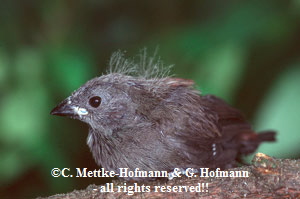
The clutch size is three to seven eggs. REIMANN (1987) even mentioned eight but more common are four to five eggs. The birds usually begin incubating their clutch after the third egg. The female takes over the bigger part of incubation. In our pairs the females spent about 66 percent in the nest and only one male of our pairs took over more of the incubating job than his female. Only rarely, both partners were in the nest at the same time. This mostly was an indicator that either the chicks were hatching or the female had problems laying an egg. At night, only the female is in the nest and the male stays well hidden in the vicinity of the nest in dense shrubbery. After about 13-14 days the nestlings hatch. Under bad weather conditions in outdoor-aviaries or in nervous pairs which incubate their clutch with a lot of interruptions hatching is delayed for another two or even up to four days. Even without regularly controlling the nest it is very easy to detect that the nestlings have hatched. The parents will so obviously begin to search for live-food that this behavioral change is a perfect indicator for hatching. During the first couple of days after hatching live- and egg-food is the main diet for the chicks, after about seven days half-ripe and germinated seeds take over this role. In many cases, in particular with birds caught in the wild the first breeding attempt will fail. Often the reason is that the birds are simply not used to the offered food and they still look for what they were used to in the wild.
Another reason maybe the way we offer the food; for instance some pairs might accept novel food sprinkled on the ground but won’t accept the same food offered in dishes. Of course over time they will get used to it and again this is mainly true for birds caught in the wild. But it is also valid for birds raised in large outdoor aviaries under semi natural conditions.
As mentioned already we force the birds to search for their food. After all this is the natural foraging behavior of the species and as a consequence they have to work for their high energy/protein food. This increased workload for the birds helps prevents that they start a new brood before raising the nestlings of the current brood. Another good strategy to prevent the abandoning of nestlings is to offer the different types of insects sequentially, i.e. providing insect A the first few days and then insect B the following days and so on. Some of our pairs had the annoying tendency to suddenly refuse the offered live-food after one to three days but they kept on feeding when other live-food was offered – food which they knew already but was not offered the last couple of days. With this new stimulus they were raising their nestlings diligently; without they would fail to do it. But to be honest we had these difficulties only in very rare cases. Usually our pairs could serve as examples of the perfect parents and often we had to stop the breeding season as we didn’t know where to go with all the youngsters.
The nestlings grow very rapid. With about five days the feather-shafts will open. Around day six the young open their eyes and around day 17 they leave the nest. If they need significantly longer to fledge it often indicates an insufficient supply of protein. Cool weather can also be responsible for the delay. After fledging the young stay in closest vicinity to the nest. Often they sit snuggled close together in dense vegetation, well camouflaged with their inconspicuous plumage-coloration. The first couple of days after fledging the parents like ushering their offspring back to the nest. Such as the young Dybowski’s of QUUOS (1990) our fledged Dybowski’s spent most of the time in dense vegetation low above the ground whereas birds of other breeders spent most of the time on the ground. Young birds that grow up in deprived cages which are equipped only with the famous three perches and nesting boxes tend to fledge later (about 2-3 days) even with a sufficient diet and after fledging they spend the first couple of days on the cage floor. But the reason for this is simply that the necessary vegetation near ground level is missing (the same of course is true for deprived aviaries). Shrubs near the ground are especially important for birds which are housed in aviaries with a cold floor; the microclimate in this dense vegetation is much more suitable then cold concrete floor. As it seems to suit the need of the young Dybowski’s we offered low vegetation even in cages and all our young Dybowski’s readily went for it. When the young are around 20-22 days old they join their parents during foraging and try to feed on soft food items like ant-pupas or egg-food for the first time. Approximately two weeks after leaving the nest the fledglings are independent. After spending another week with their parents, they should be separated from their parents if they are not housed in a large well planted aviary. Although the parent-fledgling conflicts (especially the father/sons) usually start after the young have finished their first molt into adult plumage, the father sometimes starts to chase the young earlier in particular when they are housed in a cage. The winner in this case is always the adult male. So separating the young three weeks after fledging is a good method to be on the safe side. The young molt very fast, some of our birds have already started their molt 8-10 days after leaving the nest. With approximately 3 months all of our young had finished molt and could only be distinguished from their parents by the smaller stature. In our birds we found that the juvenile males need about one to two weeks longer with their molt than the females. As a result of their fast, rapid development Dybowski's Twinspots try –when allowed - WHAT WE DON’T RECOMMEND - their first breeding attempt when they are less than six months old. Our youngest successful breeding pair was a four months old male and a 3.5-month-old female. This is possibly an adaptation to the conditions in the wild where optimal conditions for raising offspring are rare. In this in this case it is better to breed early in life than never. But in no way we would recommend it for breeding the birds in captivity, the risk to lose a female because of egg-binding is much higher in such young birds. We recommend waiting until the birds are at least ten months old. The success rate with birds of this age is much higher and the risk to lose the female because of egg-binding is drastically reduced.
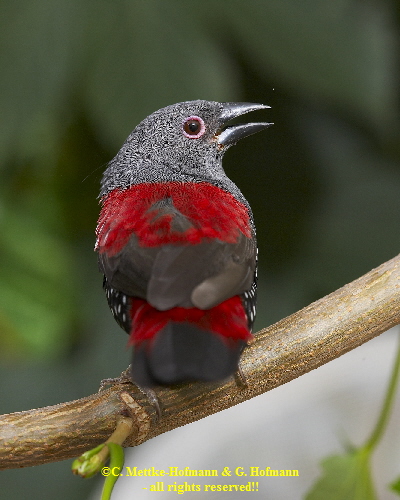 |
Among the African -Estrildians Dybowski’s Twinspots certainly belong to the easiest to breed species. They are usually diligent parents which adapt fast to new housing conditions and accept new food quite fast as well. But of course the plasticity of the species has its limits. When we keep and feed the species in the range they are adaptable to success is granted. The reason for the decline in popularity in recent years has probably been the vast amount of imported birds as well as the aggressiveness of the species. Well bird-flu changed it all, now the number of birds available is small. With a bit of luck and a lot of effort the finch-lovers hopefully succeed to establish a viable population in captivity as they did with the Painted Firetails after the Australian export-ban in 1960.
All images and text and are Copyright © 2010 of Hofmann-photography and may not be used without the permission of the authors.
AMSTUTZ; F. (1981): Dybowskis Tropfenastrild. Gef. Freund (28): 30-32
AUL, M. (1989): Zucht des Dybowkis Tropfenastrild. AZN (36): 658-660
BANNERMANN, D.A. (1953): The birds of West and Equatorial Africa, Vol.2. Oliver and Boyd, Edinburgh and London
CHAPIN, J.P. (1954): The birds of Belgian Congo. Bull. Amer. Mus. Nat. Hist. 75B.
BIELFELD, H (1973, 1996): Das Prachtfinkenbuch, Stuttgart. Ulmer Verlag
CLEWING, T. (1988): Haltung und Zucht des Dybowski-Tropfenastrilds. Gef. Welt (112):14-15
GEIGER, E. (1965): Neues vom Dybowskis Tropfenastrild (Euschistospiza dybowskii). Gef. Welt (89): 178.
GOODWIN, D.(1982): Estrildid Finches of the World. British Museum (NH), London.
GRÖTZ, E. (1977): Dybowkis Tropfenastrild, Grauer Tropfenastrild. AZN (24): 78-79
IMMELMANN, K., STEINBACHER, J. & WOLTERS, H.E. (1963, 1975): Vögel in Käfig und Voliere: Prachtfinken: 74-77, 526-528
KUJAWA, W. (1965 a): Zum Kauf von seltenen Prachtfinken. AZN (12): 185-186
KUJAWA, W. (1965 b): Die Erstzucht des Dybowskis Tropfenastrilds (Euschistospiza dybowskii). Gef. Welt (89): 222-225
MOREL, (1972
PAYNE, R.B. & L.L. PAYNE (1995): Song mimicry and association of brood-parasitic indigobirds (Vidua) with Dybowskis Twinspot (Euschistospiza dybowskii)
PENSOLD, R. (1968): Erfahrungen bei der Zucht von Dybowskis Tropfenastrilden. Gef Welt(92): 181-182
PENSOLD, R. (1968): Nachtrag zu „Erfahrungen bei der Zucht von Dybowskis Tropfenastrilden“. Gef. Welt. (1968) 224-225
PENSOLD, R. (1974):Beobachtungen am Dybowskis Tropfenastrild. Gef Welt (98):109-110
QUOOS, D. (1990): Teufel mit Charme: Dyboskis Tropfenastrild. Gef Welt (114):301-303
REIMANN (1987) : Käfigzucht des Dybowski Tropfenastrilds. Gef. Welt (111): 213-214
ROBILLER, F. (1978): Prachtfinken – Vögel von drei Kontinenten, Berlin
URLEPP,O. (1980): Vergleichende Beobachtungen über die Geschlechtsbestimmung bei seltenen Prachtfinkenarten. Gef. Welt (104):129-130
VIT, R. (1992): Erfahrungen mit Dybowskis Tropfenastrilden. (Euschistospiza dybowskii).. Gef Welt 116: 274-276
VOGEL, J. (1987): Der Dybowskiastrild – Ein Erfahrungsbericht. Voliere (10):333-334
WOLTERS, H.E. (1963): Neueinführung einer seltenen Prachtfinkenart. Gef. Welt (87): 118.
|
|